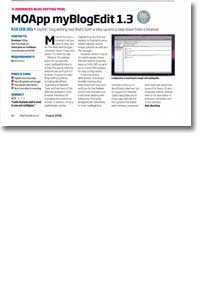
Review: Elgato EyeTV Sat
- Article 79 of 89
- MacFormat, October 2009
Receive and record Freesat on your Mac with a little bit of work
Back in the good old days, all you had to do to get television was stick up an aerial and plug it into your TV set. Now there’s a world of choice, ranging from old-style analogue television through digital Freeview and cable TV through to BSkyB.
In that mix is Freesat – basically, Freeview via satellite but with a slightly different channel line-up. Freesat is free, can get a good signal almost anywhere, and even has HD channels. However, recording TV on your Mac directly is something that has only been possible with Freeview and analogue, not Freesat – until now.
At just 14cm long and 10cm wide, Elgato’s EyeTV Sat is a surprisingly small and simple affair compared with other set-top boxes. It has a power plug, a connector for a satellite lead, a USB output and a CI slot – irrelevant to the majority of users but useful for those who want to watch subscription adult and overseas channels. Freesat and Elgato say you should be able to use any satellite dish that can receive UK channels including BSkyB’s, so for our review, we used the lead that normally runs from a communal satellite dish to a SkyHD+ box to provide a signal.
Configuration is simple: just drag and drop EyeTV from the CD to install it; then launch it and let the set-up assistant tune in the channels. After a slightly baffling moment when we were given a highly technical choice of satellites, we were able to get EyeTV to scan for channels. Since Freesat uses a proprietary EPG system that EyeTV can’t process, the EyeTV Sat also comes with a one-year subscription to tvtv.co.uk to generate programme listings. The software was able to match up most channel names with tvtv.co.uk and give us an EPG, once we’d downloaded the relevant information off the Internet, although the slightly patchy tvtv.co.uk didn’t have listings for all the channels.
The EyeTV recording software is second-to-none. It’s easy to use, records in the native MPEG2/H.264 format, can export to iPods, iPhones and AppleTV at appropriate resolutions, and has sophisticated PVR features such as smart guides for automatically recording programmes that match certain rules. It can even auto-start a shutdown Mac if a programme is due to begin.
The PVR software isn’t the problem, though. Although Elgato says EyeTV’s auto-tune should find all Freesat channels very easily unless there’s bad weather, we had significant problems. After auto-tuning, we could get BBC1, ITV1, Five and a selection of digital channels, including BBC1 HD in fantastic quality. To get BBC3 and BBC4, we needed to run auto-tune again after 7pm when the channels transmit. ITV1 HD is trickier still since it’s ‘frequency agile’: you may have to retune the EyeTV Sat software each time you want to watch ITV1.
However, to get ITV2/3/4, Channel 4 and E4/More4/Film4 digital channels, we had to use the “Manually Add Channel” option and input no less than four separate transponder frequencies gleaned from http://www.lyngsat.com/28east.html – needless to say, most people aren’t going to know how to do this. We’re unsure why there was such a problem, since the channels came through crystal clear once we added them.
Once configured, the EyeTV Sat is a great bit of kit. But it’s far harder to use than it should be at the moment thanks to those tuning issues.


